During the flowering stage of tomato crops, the threat of pests can significantly impact yield and quality. Identifying the symptoms, implementing effective control measures, and adopting preventive strategies are essential for a successful tomato harvest. This blog delves into the world of pests that target tomato plants during their flowering phase. We will provide accurate and scientifically-backed information on the symptoms to watch out for, precise control methods, and proactive prevention techniques.
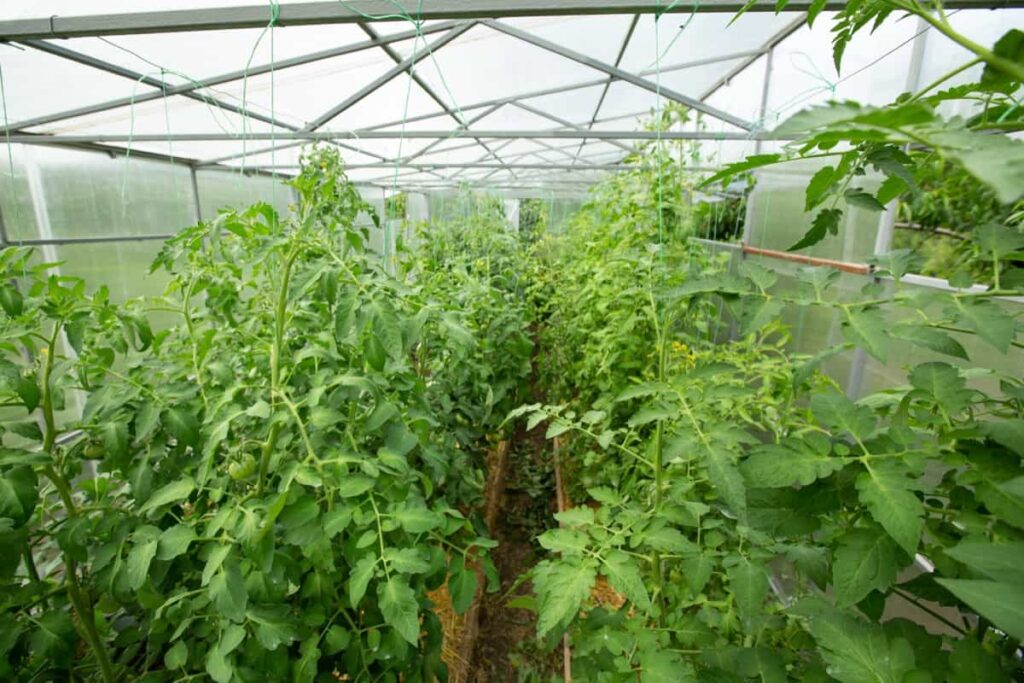
Introduction to Tomato Crops at the Flowering Stage
The flowering stage in tomato crops is a pivotal period characterized by distinct features and specific timing. Depending on temperature and tomato variety, this phase typically occurs 30 to 45 days after transplanting. During this time, tomato plants undergo a remarkable transformation, shifting their focus from vegetative growth to reproductive development.
One of the standout features of the flowering stage is the emergence of delicate, often yellow blossoms on the tomato plants. These blossoms promise future fruit, making this phase a crucial determinant of yield. Each flower has both male and female reproductive organs, and pollination is essential for fruit set.
The timing of the flowering stage can vary between different tomato cultivars. Indeterminate varieties tend to have an extended flowering period, producing flowers continuously throughout the growing season. Conversely, determinate varieties experience a more concentrated flowering phase, resulting in a more synchronized fruit set.
Common Pests Found in Tomato Crops During Flowering Stage
Aphids: These tiny, sap-sucking insects are a common menace during the flowering stage. They can distort new growth and transmit diseases. Aphids reproduce quickly, making early detection and control crucial.
Whiteflies: Whiteflies are notorious for their ability to transmit harmful viruses to tomato plants. They are small, white insects that gather on the undersides of leaves. Monitoring and using sticky traps can help manage their populations.
Thrips: Thrips are slender insects that feed on tomato leaves and flowers. They can cause silvering or bronzing of leaves and damage to developing fruit. Effective control often involves using biological predators.
Spider Mites: These tiny arachnids can cause stippling on leaves, reducing photosynthesis. They thrive in hot, dry conditions, making proper irrigation and managing dust crucial.
Cutworms: Cutworms are nocturnal caterpillars that feed on young tomato plants at the base, causing them to wilt or topple. Protecting seedlings with collars and practicing crop rotation can help prevent cutworm damage.
In case you missed it: 15 Best Tomato Nettings to Support Trellis, Protecting from Insects, Squirrels. and Birds
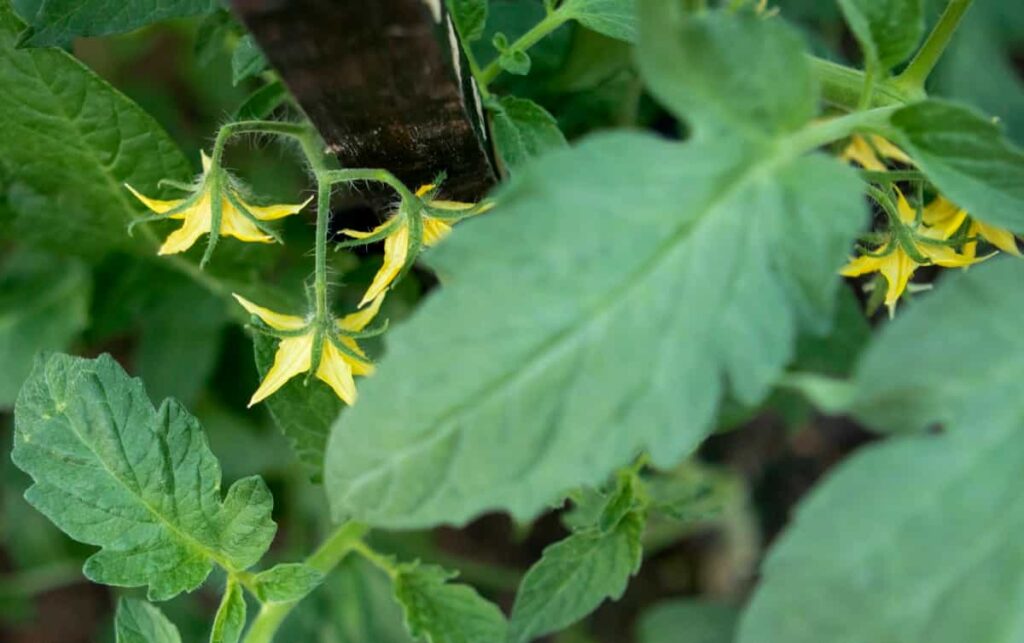
Tomato Hornworms: These large green caterpillars can devour tomato leaves and fruits. Hand-picking and using biological controls like parasitoid wasps are effective against them.
Fruitworms: Various species of fruitworms, like the tomato fruitworm and corn earworm, can damage fruit during the flowering stage. Monitoring and applying insecticides when necessary are common control methods.
Pests Affecting Tomato Crops At Flowering Stage: Identification and Management
Aphids (Myzus persicae, Aphids gossypii)
These are troublesome insects that can wreak havoc on tomato crops during the flowering stage. Identifying and managing these pests is crucial for a successful harvest.
Symptoms
Aphids are notorious for their sap-sucking behavior, targeting the tender leaves of tomato plants. As they feed, they inflict damage in multiple ways.
- Deformed Foliage: Aphids’ feeding disrupts the normal growth of tomato leaves, resulting in distortion and curling. This deformation affects the plant’s aesthetics and hinders its ability to carry out photosynthesis effectively.
- Stunted Growth: The constant sap extraction weakens the plant’s health, leading to stunted growth. Smaller, less vigorous tomato plants are less likely to produce a bountiful harvest.
Control Measures
- Chemical Control: Employing insecticides like Rogor (Dimethoate 30% EC), Confidor Super (Imidacloprid 30.5% SC), or Movento Energy (Spirotetramat 11.01% + Imidacloprid 11.01% SC) can help combat aphid infestations. These chemicals disrupt aphid feeding and reproduction.
- Proper Application: Dilute the chosen insecticide according to recommended rates (e.g., 1 to 2 ml per liter of water for Rogor) and apply it thoroughly to affected plants.
- Regular Monitoring: Consistent monitoring of your tomato crop is essential. Early detection of aphids allows for prompt intervention, preventing population explosions.
Whiteflies (Bemisia tabaci)
These can be a persistent threat to tomato crops during the flowering stage, causing symptoms that can severely impact plant health. Understanding their behavior and employing control measures to manage whiteflies effectively is crucial.
Symptoms
Whiteflies, with their voracious feeding habits, can inflict noticeable harm on tomato plants
- Leaf Distortion: These tiny insects extract sap from tomato leaves, leading to distortion and malformation. Infected leaves may appear twisted or puckered.
- Curling Leaves: Whitefly feeding often causes tomato leaves to curl downward, disrupting their normal growth patterns.
- Drying and Stunted Growth: As whiteflies drain the sap from tomato plants, leaves may dry up and turn yellow. Prolonged infestations can lead to stunted and bushy plants with shortened internodes, reducing plant vigor and fruit production.
Control Measures
- Chemical Control: Utilize insecticides like Pegasus (Diafenthiuron 50% WP), Lancergold (Acephate 50% + Imidachloprid 1.8% SP), or Confidor (Imidacloprid 17.8% SL) to disrupt whitefly populations. These insecticides target whiteflies at different life cycle stages, reducing their numbers.
- Proper Application: Dilute the selected insecticide according to recommended rates (e.g., 0.5 to 0.75 gm per liter of water for Pegasus) and ensure thorough coverage of affected plants.
- Integrated Pest Management (IPM): Employ IPM practices, such as introducing natural predators like parasitic wasps or encouraging beneficial insects like ladybugs, to provide long-term control while minimizing pesticide use.
In case you missed it: 15 Best Tomato Cages with Price for Pots, Large Plants, and Indeterminate Tomato Vines
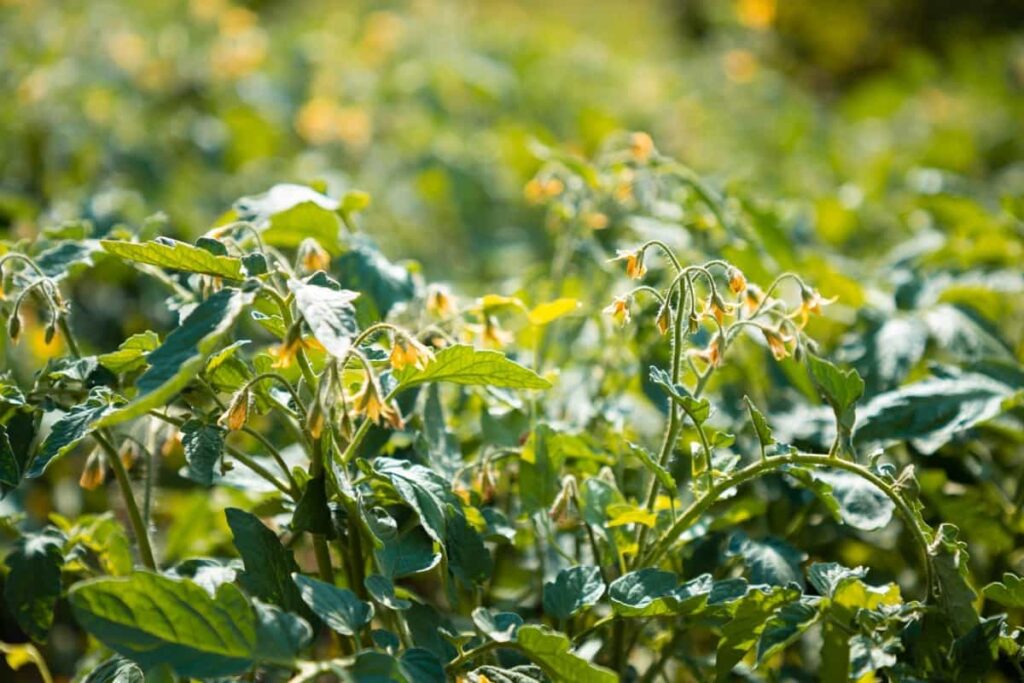
Thrips (Thrips tabaci)
These can be a vexing challenge for tomato crops, particularly during the flowering stage. These minuscule insects not only directly damage plants but also have the potential to transmit harmful viruses, such as Tomato Spotted Wilt Virus (TOSPO). Understanding their impact and employing effective control measures is essential for safeguarding your tomato harvest.
Symptoms
Thrips are notorious for their piercing-sucking mouthparts, which they use to feed on tomato leaves and fruits. Their feeding can cause several issues:
- Feeding Damage: Thrips puncture plant tissues, extracting sap and leaving behind small, silvery scars on leaves and fruit. This feeding damage can lead to reduced photosynthesis and diminished fruit quality.
- TOSPO Transmission: The most alarming aspect of thrips infestations is their potential to transmit TOSPO. This virus can devastate tomato crops, causing various symptoms, including wilting, necrosis, and stunted growth.
Control Measures
- Chemical Control: Consider insecticides like Delegate (Spinetoram 11.7% SC), Admire (Imidacloprid 70% WG), or Gracia (Fluxametamide 10% EC). These options target thrips and can help reduce their populations.
- Application: Dilute the chosen insecticide following recommended rates (e.g., 1 ml per liter of water for Delegate) and ensure thorough coverage of affected plants.
- Virus Management: Since thrips can transmit TOSPO, it’s also essential to employ virus management strategies, such as using virus-resistant tomato varieties and implementing strict sanitation practices to reduce thrips populations.
Red Spider Mites (Tetranychus spp.)
These pose a significant threat to tomato crops, particularly during the vulnerable flowering stage. These tiny arachnids are known for their sap-sucking behavior, which can lead to a range of symptoms and, in severe cases, substantial crop damage.
Symptoms
Identifying red spider mite infestations early is crucial for effective control. Key symptoms include
- Leaf Damage: Red spider mites feed on tomato leaves, causing the lower leaf surface to display reddish-brown or bronze-toned patches. This damage disrupts photosynthesis, reducing the plant’s ability to produce energy.
- Silken Webbing: In severe infestations, red spider mites produce silken webbing, which can cover leaves, flowers, and even fruit. This webbing affects plant aesthetics and can trap and smother beneficial insects.
- Withered Foliage: As red spider mite populations grow, plants may exhibit withered and dried foliage, compromising plant health and yield.
In case you missed it: Common Tomato Pests and Diseases: Prevention, Treatment, and Control Management
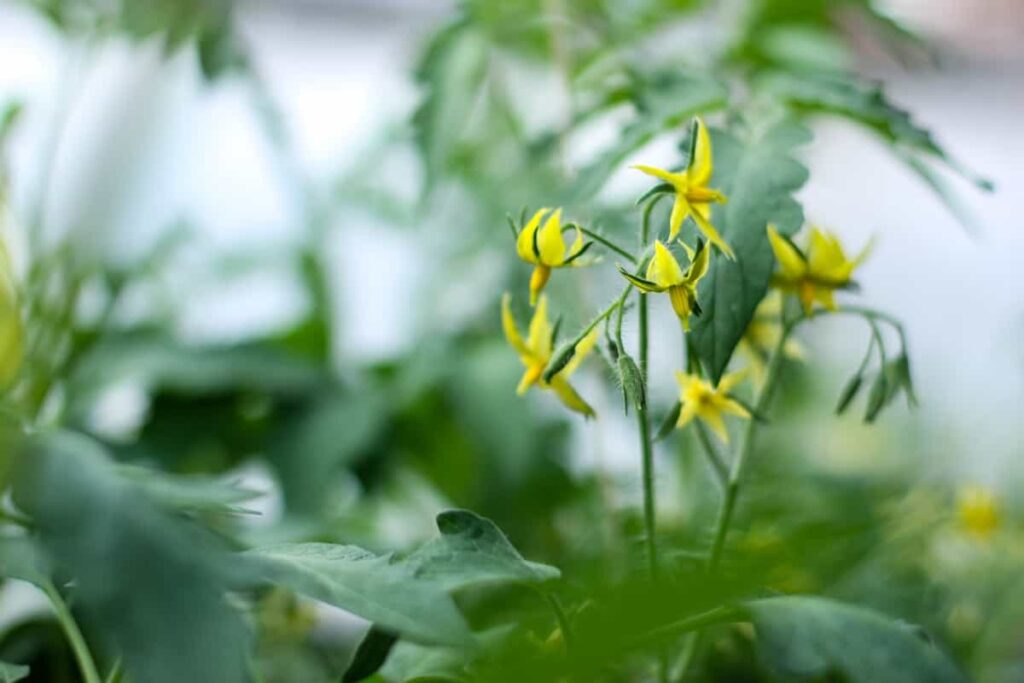
Control Measures
- Chemical Control: Consider using insecticides like Floramite (Bifenazate 240 SC), Pyromite (Fenpyroximate 5% EC), or Magister (Fenazaquin 10% EC) to combat these pests effectively.
- Proper Application: Dilute the chosen insecticide at recommended rates (e.g., 0.5 to 1 ml per liter of water for Floramite) and ensure thorough coverage, especially on the undersides of leaves where red spider mites tend to reside.
- Monitoring: Regularly inspect your tomato crop for signs of red spider mite activity, particularly during the flowering stage, and initiate control measures at the first sign of infestation.
Serpentine Leaf Miners (Causal Organism: Liriomyza trifolii)
These can be a persistent concern for tomato crops, particularly during the flowering stage. These tiny dipteran insects lay their eggs within tomato leaves, resulting in distinctive winding mines and a range of symptoms that can adversely affect plant health.
Symptoms
Identifying Serpentine Leaf Miner infestations is crucial for timely intervention. Key symptoms include
- Leaf Damage: Serpentine Leaf Miners tunnel through tomato leaves, creating winding serpentine mines. These mines are visible as twisted, maggot-like trails on the leaf surface, a distinctive feature of their presence.
- Leaf Curling: As leaf miners feed and tunnel within the leaves, affected leaves may start to curl and exhibit signs of stress.
- Leaf Drying and Shedding: Severe infestations can lead to leaf desiccation and premature shedding. This loss of foliage can hinder photosynthesis and affect fruit development.
Control Measures
- Chemical Control: Consider using insecticides like Sanvex sp (Cartap Hydrochloride 50% SP), Ampligo (Chlorantraniliprole 10% + Lambdacyhalothrin 5% ZC), or Voliam Targo (Chlorantraniliprole 4.3% + Abamectin 1.7% w/w sc) to target leaf miners.
- Application: Dilute the chosen insecticide at recommended rates (e.g., 1.5 to 2 gm per liter of water for Sanvex sp) and apply it thoroughly to affected plants.
- Regular Monitoring: Consistent inspection of tomato crops during the flowering stage is vital to promptly detect and address Serpentine Leaf Miner infestations.
Tomato Fruitworms (Helicoverpa zea)
These can wreak havoc during the flowering stage. Symptoms include fruit damage with entry holes, tunneling, and frass (insect excrement). Effective management involves regular inspection of eggs and larvae on foliage, applying Bacillus thuringiensis (Bt) insecticides for organic control, or chemical insecticides like spinosad for conventional farming. Cultural practices like removing infested fruit can also help.
In case you missed it: Growing Tomatoes Organically in Andhra Pradesh: Requirements, Planting to Harvesting Guide for Beginners
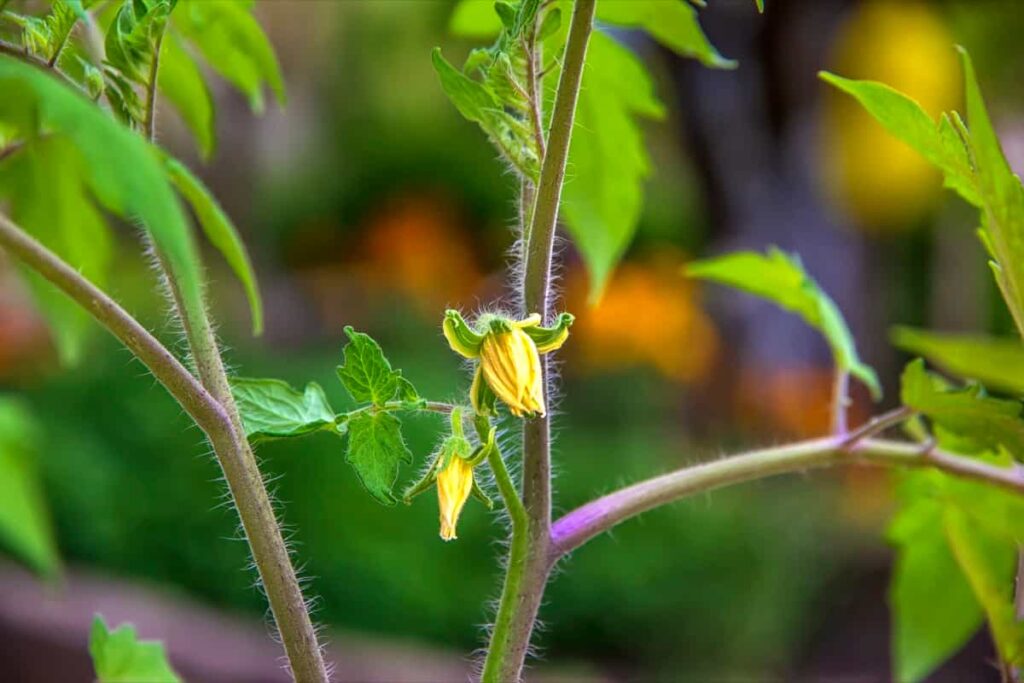
Root Knot Nematodes (Causal Organism: Meloidogyne incognita)
These pose a serious threat to tomato crops during the flowering stage. These microscopic worms infiltrate plant roots, causing root-knot galls, stunted root growth, and nutrient depletion, ultimately leading to plant death. Effective control measures are essential:
- Chemical Control: Utilize Velum Prime Nematicide (Flupyrum 34.48% SC) at 250 to 500 ml per acre, applied 55 to 60 days after planting.
- Biopesticides: Enriching FarmYardManure with bio-pesticides can be beneficial. Recommended dosages include Paecilomyces lilacinus, Pseudomonas fluorescens, or Trichoderma spp. (2 to 3 kg/ton of FYM). Mix with FYM, incubate for 15 days with 25-30% moisture, and apply before transplanting tomato seedlings.
Pinworms (Tuta absolute)
These can be destructive pests for tomato crops during flowering. They infest various parts of tomato plants, including buds, leaves, stems, and flowers, causing mining damage and laying eggs on the leaves’ undersides. This damage results in clear patches filled with excrement (frass) and stems boring. Effective control measures involve using insecticides like Belt Expert (Flubendiamide 19.92% + Thiacloprid 19.92% SC), Vayego (Tetraniliprole 200 g/L SC), or Exponus (Broflanilide 300 G/L SC) at recommended rates.
Flea Beetles
Thses threaten tomato crops during the flowering stage, creating irregular holes and a “shot-hole” appearance. To control them, integrated pest management practices such as crop rotation, resistant varieties, row covers, encouraging beneficial insects like ladybugs and parasitoid wasps, and considering chemical control like insecticides formulated for flea beetle control, following recommended rates and safety guidelines.
Leafhoppers
These can significantly threaten tomato crops during flowering, causing leaf discoloration, reduced photosynthesis, and disease transmission. A multi-pronged approach is needed to manage them, including cultural practices like weed control, biological control like encouraging natural predators, targeted insecticides if populations become problematic, and regular monitoring for signs of leafhopper activity.
In case you missed it: Nutritional Deficiencies in Tomato Crop: How to Fix, Solutions, and Treatment
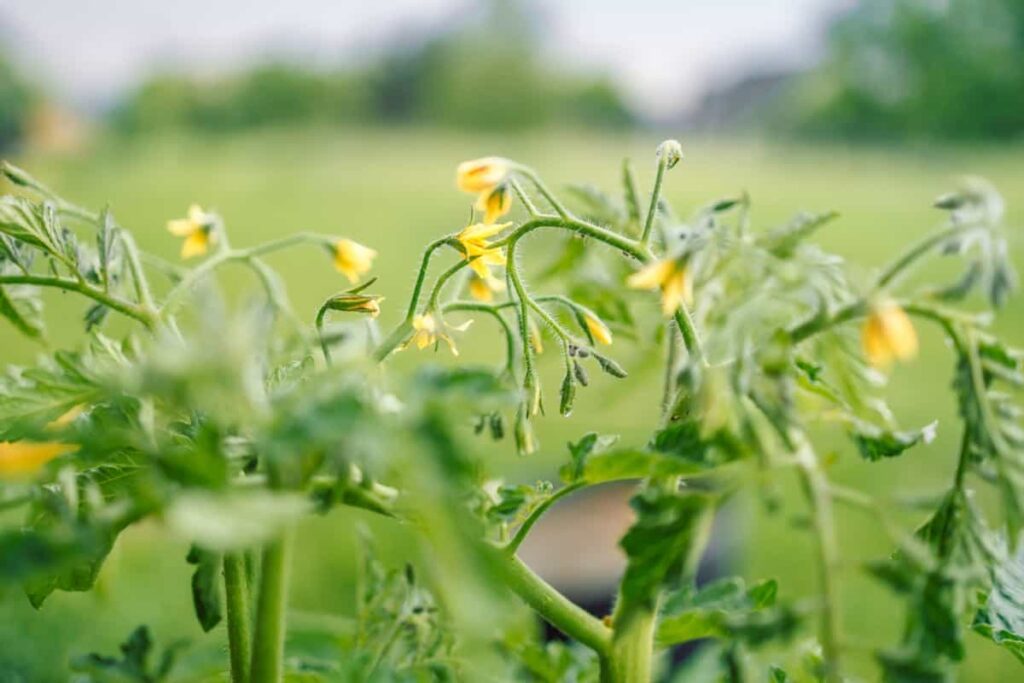
Conclusion
Protecting tomato crops during the flowering stage from pests is vital for a successful harvest. Identifying early symptoms and implementing precise control measures, including targeted insecticides and integrated pest management, are key to safeguarding plant health and ensuring abundant tomato yields.
- Crops Grown in Summer Season: Best Choices for Summer Gardening
- Organic Pest Control for Tomato Farming
- How to Maximize Sheep Farming Profit
- Broccoli Varieties: Choosing the Right Cultivars for Your Farm
- How to Raise Pigs in Your Own Backyard: A Comprehensive Guide
- Budget Friendly Sheep Shed Ideas: Cheap and Low-Cost Tips
- How Much Do Cattle Farmers Make: Revenue Streams in Cattle Farming
- Management Pests and Diseases in Your Cotton Field
- Sheep Farming Business Plan for Beginners
- Aquaponic Farming at Home: A Step-By-Step Guide
- Profitable Village Farming Business Ideas in 2024
- High-Yield Aquaculture: Fast-Growing Fish for Farming
- Effective Fish Pond Construction Techniques for Beginners
- Irrigation and Water Management in Pineapple Farming
- Blossom to Harvest: Mastering Flowering and Pollination in Papaya Farming
- Pig Fattening Essentials: From Selection to Sale for Beginners
- Raising Wagyu Cattle: A Complete Guide for Premium Beef Production
- Soil Types and Their Water Holding Capacity
- Optimizing Irrigation Schedules for Coconut Groves for Enhanced Yield
- Espresso Your Garden: Coffee Grounds for Healthier Acid-Loving Plants
- The Best Soil Mix for Snake Plants: How to Mix Your Own Snake Plant Soil
- Green Thumb Success: Expert Tips for Cultivating Greenhouse Beans All Year Round
- Bloom All Year Round: The Ultimate Guide to Indoor Hyacinth Care
- Eco-Friendly Gardening: How to Make Liquid Fertilizer from Kitchen Waste
- Ultimate Guide to Grow Anise in Pots: Explore Seed Propagation to Harvesting
- Guide to Raising Chester White Pigs: Discover Breed Facts to Growth Management
- Mastering the Elegance: The Ultimate Guide to Weeping Cherry Tree Care, Planting, and Maintenance
- Ultimate Guide to Planting Garlic in Grow Bags: Growing Strategies for Beginners
- How to Fix Spider Plant Leaf-Related Problems: Natural and Organic Remedies
- 10 Reasons Why Your Tulsi Plant is Shedding Leaves: Home Remedies and Solutions
- Optimizing Growth and Yield: The Advantages of Palm Bunch Ash Fertilizer
- Utilizing Neem Oil Extract as a Natural Pesticide for Hydrangea
- From Soil to Harvest: Various Ways in Which Farmers Can Use AI Tools
- Steps to Encourage and Induce Citrus Flowers: A Comprehensive Guide
- How to Fix Snake Plant Leaf-Related Issues: Natural and Organic Remedies
- Transform Your Garden into a Fragrant Oasis with Raat Ki Rani (Night Blooming Jasmine)
